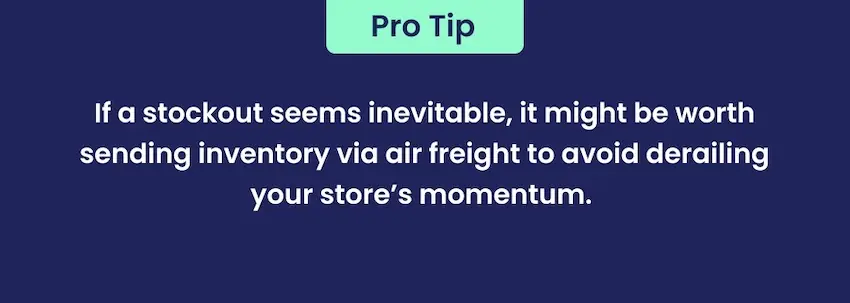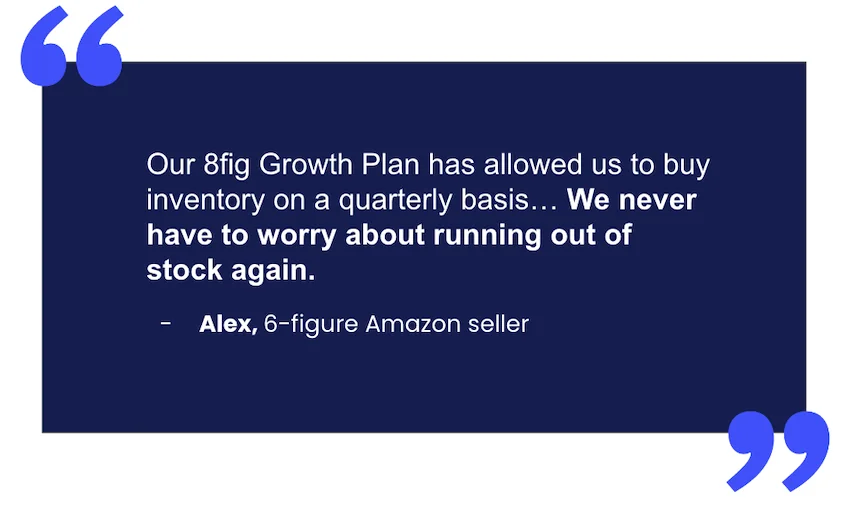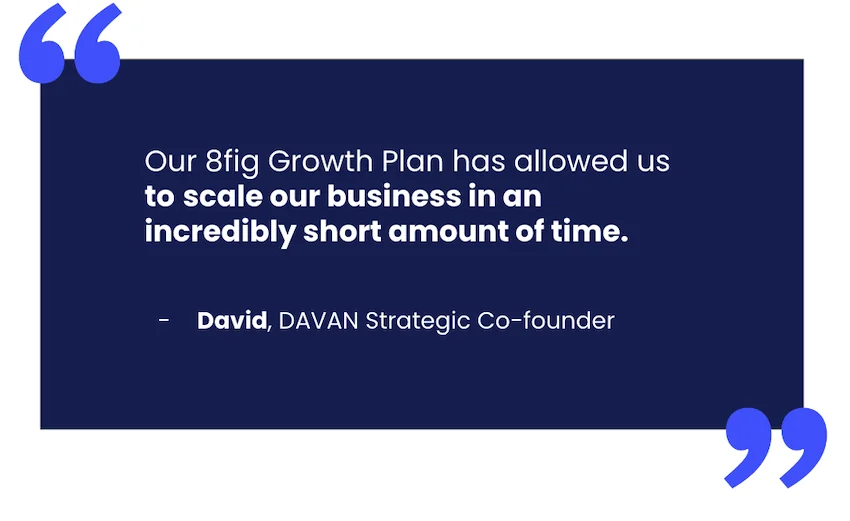Podcast: why running out of stock harms your Amazon store
In this podcast, Dana Oren, 8fig’s VP of Product, shared her expertise regarding selling on Amazon and stockouts on the platform. Running out of stock appears to be a ‘champagne problem’ since selling out should be a good thing, in theory. However, there are many hidden downsides that sellers need to understand before launching their Amazon store. A good comprehension of the platform’s algorithms and rules can be the difference between a business that succeeds and one that doesn’t.
Are You Ready for the Best-Case Scenario?
When starting out, a lot of sellers try to prepare for what most think of as the worst-case scenarios. These involve their pricing being wrong, the product not resonating, or getting too many negative reviews. Selling out isn’t a matter many store owners think of as something they need to prepare for. If anything, it can seem to be a goal to strive towards.
Surges in demand can come at surprising times. Maybe your ads are overperforming, a TikToker mentioned you, or a competitor is out of stock, funneling more traffic to your store. All of these things can happen. And when they do, there is a good chance that you will run out of inventory before your next shipment comes in.
Why Selling Out on Amazon Is a Bad Thing
Once you start running low on stock, you lose customers to the competition. Similarly, if a competitor depletes their stock, all their business is diverted to you. When faced with products that aren’t available, a customer who was interested now delays their purchase. They might come back but it’s unlikely.
This situation is particularly bad for sellers who offer products that rely on recurring purchases. For example, when selling supplements or pet food, running out of stock might mean customers find a different seller or product that they subscribe to instead.
Finally, if you do sell out, you are going to experience hits to your organic search ranking on Amazon. These have a crucial impact on your sales and conversions. The higher you are ranked, the more prominently your products will be displayed on customer search pages. When your ranking falls, competitors will quickly come in to take your place. That makes regaining your position an uphill battle, even once you have restocked.
What To Do When Sales Accelerate
Long before a stockout happens, every seller should be closely monitoring their sales and store data. Doing so allows you to feel the pulse of your business and monitor its health. It also provides early warnings when a stockout looms. You will be able to see how many days of projected stock you have left. With this information, you can figure out the best time to order your next shipment of inventory.
8fig’s free platform lets you see your daily sales performance, and benchmark it against the previous week, or the week before it. You can see all the way back to the previous year and see how your store is performing in comparison. The 8fig dashboard gives a clear overview of daily sales numbers, helping you understand your store’s and products’ performance.
Once you realize that you’re about to sell out, the first step is to talk to your supplier. It is important to find out what options you have to replenish your stock. If your supplier can provide the goods that you need, it is often wise to increase the volume and order early.
You also need to make sure you have enough capital on hand to buy inventory. Amazon’s payout won’t arrive sooner just because you sold out faster. You’re still going to have to wait, especially if you’re a newer seller. Such a cash flow delay can have a serious impact on your ability to order inventory in advance to avoid stockouts. An 8fig Growth Plan can provide the necessary capital to fund inventory orders well in advance.

If your freight deliveries can’t be accelerated sufficiently, and your stock continues to dwindle, you should consider slowing or even ending paid ad campaigns. This might harm your Amazon ranking but is preferable to running out of stock entirely, as long as sales don’t fully stop. Discontinuing any sales or deals is also recommended. And, if nothing else works, you can try raising prices slowly to reduce sales and ward off a stockout. In the long term, it is worth taking a hit to your profit margins to avoid running out of stock.
Prevent Stockouts Ahead of Time
The best way to avoid the possibility of running out of stock is by keeping around three months of inventory in a 3PL (third-party logistics provider). This is ideal due to the fact that Amazon has storage limits and higher warehousing fees. Having this backup stock means you have inventory ready to be shipped to your Amazon warehouse fast and for a reasonable price. Doing so will reduce the number of orders you need to make from your suppliers, which tend to be abroad, and helps keep your supply chain running smoothly.
Next, you should be auditing and streamlining your operations regularly. 8fig’s free software is great for doing this. It lets you map out and visualize your supply chain, helping you understand what dates you need to hit in order to make payments on time, ensure that stock arrives punctually, and know when to launch marketing campaigns. Consistently monitoring and improving your supply chain makes it less likely to be strained when stock runs low.
Another surefire way to reduce the bite of surging demand is to create a contingency plan with your supplier early on. This entails negotiating conditions for future situations when you need to increase volume fast. Just like you, suppliers are business people, and if they sense that you are desperate for their products, they might leverage that for higher prices. However, if you set terms ahead of time, such as the timeline and cost of additional orders, you can save yourself from such a situation.
Finally, ordering smaller shipments more frequently is a great way to avoid stockouts. It will make it easier to respond to shifts in the market as they happen. For example, a rhythm of shipments coming in every two months gives you a lot more flexibility to tell your supplier you need more inventory.
Leverage 8fig To Avoid Stockouts
Using 8fig’s services is a great way to avoid running out of stock. Through its platform, which is highly adaptable, sellers can operate 4-8 product lines per year. It gives a clear overview of every bit of data, from freight costs to shipping times. An 8fig Growth Plan also provides funding to fuel more orders, helping sellers go beyond maintaining their current level of sales, and create substantial growth.
Being able to avoid cash flow issues before they start is highly beneficial to eCommerce stores. The moment a seller needs to pay for an order can be months before they see any revenue from their sales. 8fig’s funding makes it possible to order products well in advance, eliminating headaches related to cash flow.
Seller Stories: Meet Alex and Aidan
Alex and Aidan joined 8fig in January 2021, barely qualifying as a 6-figure seller. They had hit $100,000 in yearly revenue in their first year of operations with a lifestyle brand that was their passion project. In April 2021, gridlock at the LA Harbor derailed their plans. Their container was delayed for 6 weeks, during which they ran out of stock and saw their ranking plummet.
They responded by shifting course, consolidating their orders, and focusing on bestselling products. Alex and Aidan took this disruption as a warning and tweaked their business strategy to prevent stockouts in the future. Using the capital they received from 8fig, they funded a business plan that led to them experiencing all 5-figure days in Q4 2021. Today they are 7-figure sellers, heading for 8 figures.

Seller Stories: Ryan & David of DAVAN Strategic
Ryan and David started out selling blankets. They had the desire to build success and scale sustainably. So they focused heavily on data analysis, doing their best to optimize their store’s performance. They launched in 2020 and saw products fly off the digital shelves. Unfortunately, this also involved frequent stockouts as they didn’t have the capital to order inventory far enough in advance.
So they partnered with 8fig to end their stockout cycle and maximize their performance. This meant consistent sales and allowed them to adapt their forecasting models, which they now sell as a product in itself. Ryan and David were also able to invest in new products, achieve great page visibility and reach high keyword rankings. In 2022 they were earning $6.1 million in annual revenue and sold their company for a 7-figure sum.

Never miss an episode!
More Episodes


